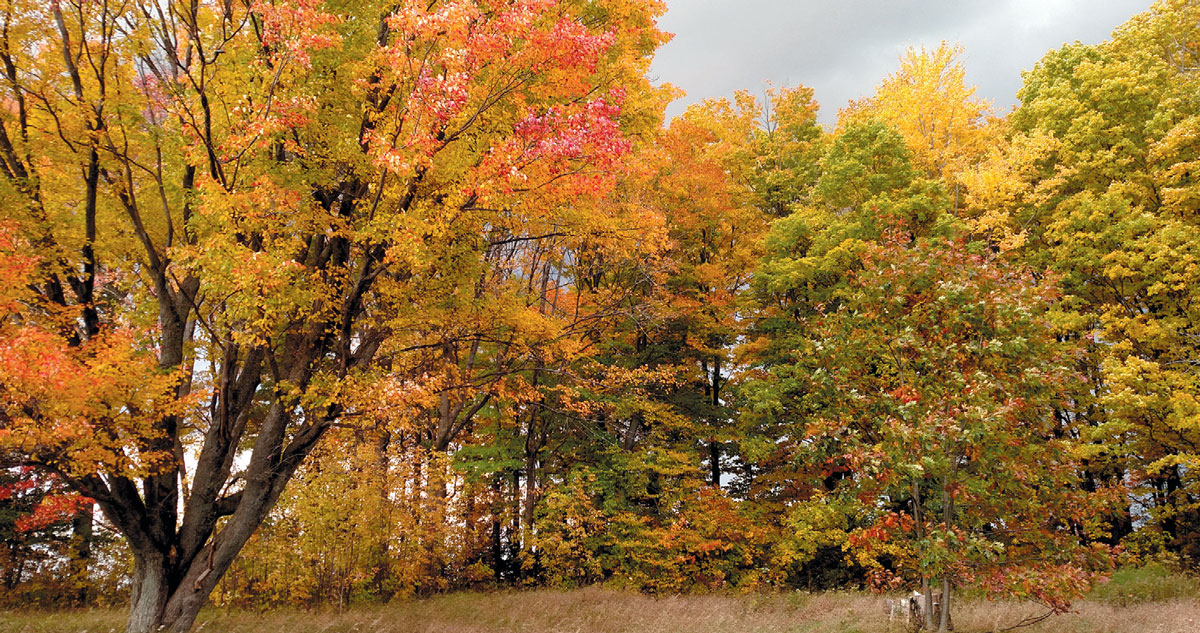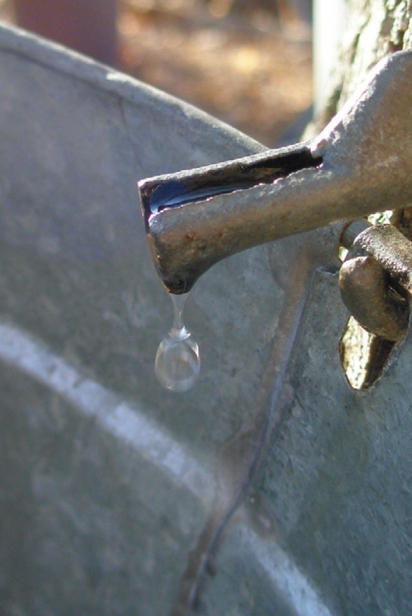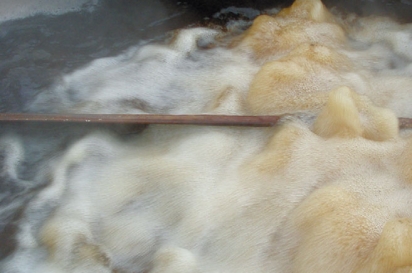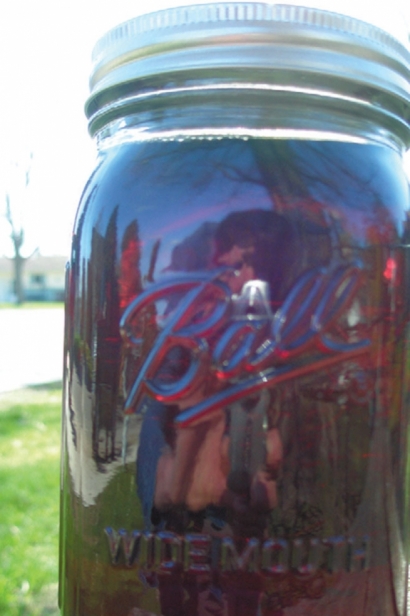Sugaring, Michigan Style
Making Syrup Stirs the Soul
While a blanket of snow still lies across the land and the cold north wind blows on, there are hardy folk who venture into the woods to collect a nectar that is so sweet, so sustaining and oh, so soulful. These people have a passion living inside them year-round, a devotion that may come from family, inspiration or the pursuit of times gone by.
During this time of year, when there is still more night than day, this clear, cold nectar flows from the very root and through the core of the mighty maple tree. The sap, the tree’s lifeblood, holds much power—and not only for the maple. The tree shares its riches, perhaps not willingly, providing what was once a staple for survival.
The roots of sugaring—that is, making maple syrup—run as deep as the roots of the maple. The Native Americans of the Great Lakes have celebrated the sap run as a time to reunite, collecting the sap and storing it for sustenance through the long, cold winter. They used to use dug-out logs and hot rocks to boil the sap to syrup or sugar. In the Ojibiwe language, April was named Sap Boiling Moon or Iskigamizige-Giizis.
Today, many people enjoy the hobby of sugaring. But for some, to call it a hobby is a bit of an understatement. For some, sugaring is a tradition now woven into the fabric of their lives and their communities.
THE ARDIS SUGAR BUSH
Brad Seger grew up in Lake City, a small rural community in Northern Michigan. He dreamed of being Daniel Boone—an American woodsman and pioneer—going back to a time when people lived off the land. An avid reader, Brad picked up The Maple Sugar Book by Helen and Scott Nearing. Their telling of the history and how-to’s of sugaring intrigued and inspired him, as did their lifestyle of self-sufficiency.
Brad took up sugaring 35 years ago while still employed at General Motors. “I’ve always tapped some trees, even in Okemos, where the neighborhood playground had some sugar maples,” he recalls.
Retired now, Brad sugars at the Ardis sugar bush—a grove of grand and glorious sugar maples just outside of Lake City.
As spring begins to nudge winter out of its way, freezing temperatures overnight give way to days that are milder, or at least just above freezing. Tapping an indicator tree at his house, Brad confirms the time he has waited for is here: The sap run has begun. Strapping on a pair of snowshoes, as the snow is still deep on the ground, Brad sets out for the sugar bush to check its conditions. To tap a tree, he drills a small hole at a slight upward angle about waist-high on the tree and inserts a spile—a spout for collecting the sap. It’s an old-timey spile—small and metal, with a hook for a bucket. Now he waits. Will this mighty maple, one he has tapped over and over again through the span of 30-plus years, reward him with its riches?
Every year, Brad sets out about 140 taps in the sugar bush. Imagine the labor! Drilling and setting taps; lugging buckets brimming with sap; cutting, splitting and stockpiling wood for the fire. But, thankfully, the sugar bush is a community.
It is a community of people—family, friends and even strangers— stopping by, helping with a piece of work, sharing a sip from the bucket. “My kids look forward to sugaring every year. Once in a while, when the season drags on, I have to urge them, ‘Put away the electronics, we’re going to the sugar bush!’ I tell them, and they do,” Brad says.
Joe Elliot, a retired elementary-school principal, is a regular at the sugar bush. “I’ve known him since I was six years old. My father died when I was 11, and Joe took me under his wing,” Brad says, adding, “People just love to stop in, and I’m real friendly.” He shares the sugar bush and its treasures willingly. “While we’re boiling, everyone is dipping in.”
It is a community of trees, too—each is given a name, like Thomas Jefferson and Barack Obama. Sometimes the names change, given for the people who join Brad at the sugar bush. “That one in the northwest corner, her name is Natalie. She’s a high producer with high sugar content,” Brad reveals. What an honor!
Brad tends to the sugar bush as a parent tends his children. “For maximum production, I will take out species other than the sugar maple, but not all at one time or it’ll dry the ground. I’ll let the young sugar maples, the ones that are straight and tall, grow to be the next generation in the sugar bush.”
PASSING TRADITIONS ALONG
Larry Shetenhelm, another born-and-raised Missaukee County native, says, “Sugaring is so much a part of me. I grew up sugaring, smelling it and tasting it as it goes along. The sap is sweet at the tree, but as it boils, it gets sweeter and sweeter.” Larry’s granddad, Ben Shetenhelm, began sugaring in 1908 when he and his wife moved from Vermontville, Michigan, to the Lake City area. Vermontville, a small town of less than 800 even now, has a rich history of maple syrup making. Home to the original maple syrup festival in Michigan, it celebrated its 75th annual festival in 2015.
Ben and his wife, Olive, both schoolteachers, bought 420 acres in the country. As they timbered the land to farm, they used the old pine stumps to mark the farm’s boundary, and also burned the wood as fuel for the stoves that boiled the sap. In the earliest springtime, Granddad Shetenhelm would set out to tap the nearly 800 maples in the sugar bush. It was an arduous task, this tapping of trees and setting of buckets, but one which Larry was more than happy to assist with. As Larry tells it, “I would get out of school to help tap the trees on Granddad’s farm. While we boiled, 24 hours a day, we would listen to a radio station out of Nashville.” The syrup they produced not only nourished the family; it also brought in money to sustain the farm.
“Granddad would bring the schoolkids out to the sugar bush. He’d boil the sap to a taffy consistency and we’d pour it over snow. Delicious! It was in his heart to share that experience and passion,” recalls Larry. Now, Larry hopes to pass his own love for sugaring on to his grandkids.
After the family farm was divided and sold, Larry kept his share to later purchase his own sugar bush. In 2007, after traveling the country serving as a pastor to rural communities, he came home to Lake City and purchased 10 acres near Jennings. The property had a mix of hardwoods, but included enough maples to seal the deal. “Most of the maples are soft maples, whose sap is not quite as sweet as sugar maples, but it still makes great syrup,” Larry explains. In all, he taps about 40 trees each spring.
Larry has built everything on his sugar bush for the purpose of sugaring. The sugar shack, which has a roof made of steel salvaged from an old church in Jennings, houses his handmade boiling stove. He even built a loo to accommodate the many long hours spent at the sugar bush.
“My true joy is having the grandkids here sugaring with me,” Larry confides. “They love being a part of it.” Larry’s grandchildren, nine in total, spend many days on Larry’s 10 acres—both working and playing. Another feature of Larry’s sugar bush is a zip line, high above the ground at the start, spanning 270 feet from one enormous oak to another. What’s not to love!
WHEN THE SAP RUNS
Operations at the Ardis sugar bush are completely open-air—no shanties or sugar shacks, no outhouses. And for Brad, that’s part of the allure. “You get to see spring come in. When you’re at the sugar bush, you get to be outdoors every day and are greeted by the first geese and robins of the season. The air is so fresh.”
The work of sugaring reaches a feverish pitch as youthful spring edges out Old Man Winter. Brad explains, “There’s a short run in the middle of February, then it will freeze again. I look for the 38° days and a freeze overnight. Sunshine really makes a big difference. The sap run is very sensitive to temperatures and weather conditions. The wind from the north cools the tops of the trees—it’ll cool them right down, and the sap run slows. Then you’ll get a calm, sunny day; that’s when it just pours. There’ll be three or four days when it runs and the buckets are overflowing. You better have had your Wheaties!”
When the sap flows generously, diligence is imperative. Brad utilizes two boiling stoves, or evaporators, to reduce his sap to syrup. “The sap will spoil in the sun—that’s why mine is the best,” he explains boastfully. “As soon as I get sap, she’s getting boiled down.” Brad also notes that the best syrup of the year is the first. “It is the most delicate and the clearest, and produces the lightest color of syrup. Back in the day, it was considered the Grade A.”
Time spent at the Ardis sugar bush with family, friends and strangers brings forth many stories. One of Brad’s favorites is from the Nearings’ book. He quotes the passage, credited to Francois Andre Michaux, circa 1810: “Wild and domestic animals are inordinately fond of maple juice, and break through their enclosures to sate themselves; and when taken by them in large quantities, it has an exhilarating effect upon their spirits.”
Brad boasts the power of the sap as an elixir. “It is crystal clear, ice cold in February, and chock-full of everything the body needs. It’s a spring tonic that can knock out coughs in no time. I drink it every day. It’ll put a skip in your step, just like the cows!”
As the sap boils down to syrup, Brad and Larry employ different methods in determining when it is ready to can. Brad uses the scientific method, measuring the relative density of the syrup with a hydrometer. Larry judges the consistency and checks the temperature, kind of like candy making. Whatever the means, the results are the same: sweet, rich goodness that only the maple can provide.
“The deal with sugaring is once you do it, you’ll keep doing it until you can’t walk anymore. Once you get the sugaring fever, you’ll always have it,” says Brad. And for Larry, “Sugaring is so much a part of me. I can smell syrup cooking in the spring, no matter where I am. It’s in my blood.”
These are just two of the many folk who venture into the woods at the first signs of spring seeking the sugar of the mighty maple. They are pulled there by a passion that runs through their veins like the sap in the trees, bringing them all back to life after a long winter’s slumber.







